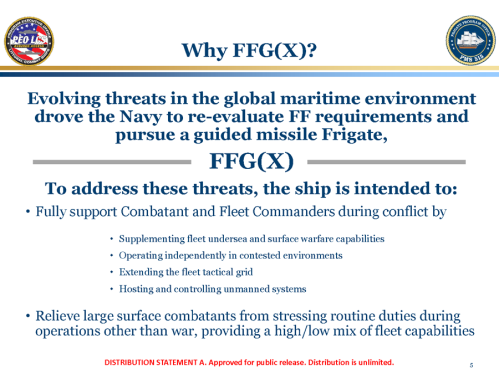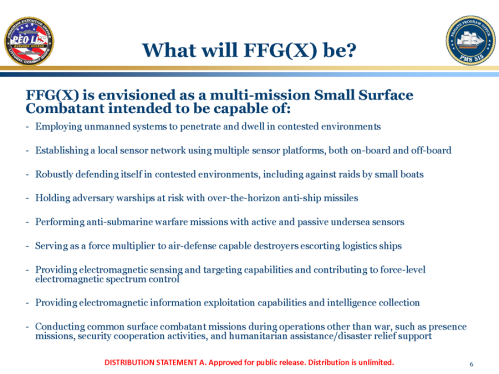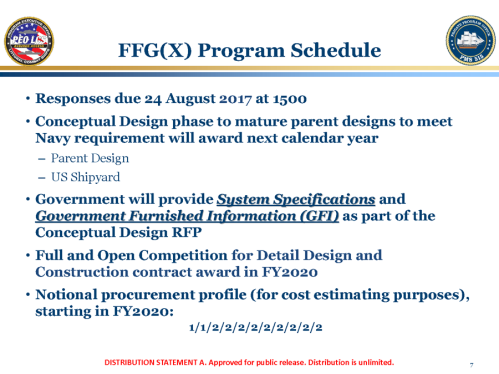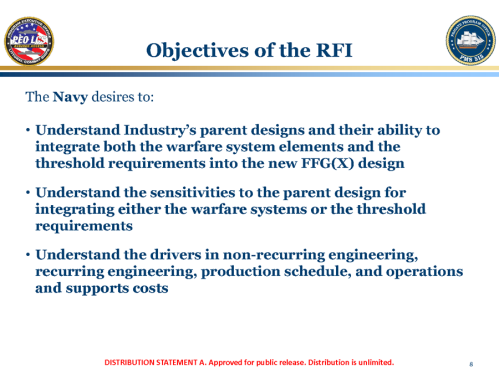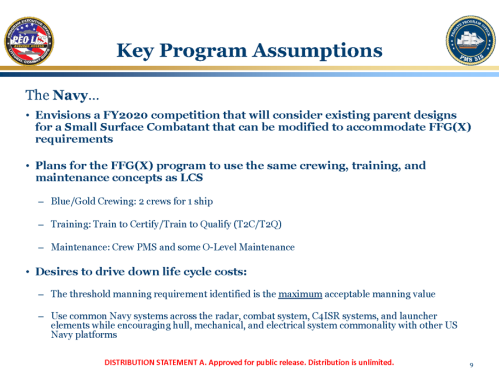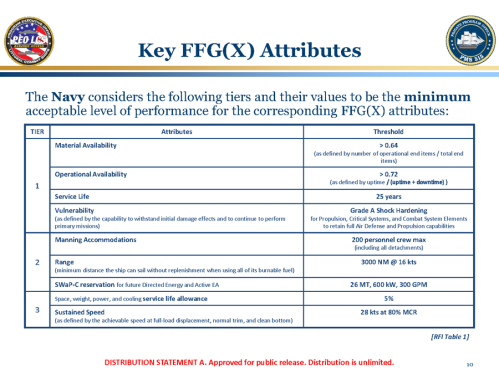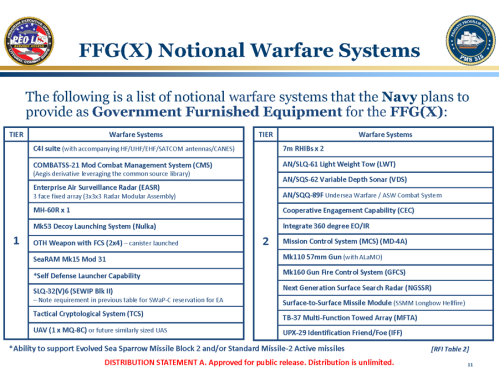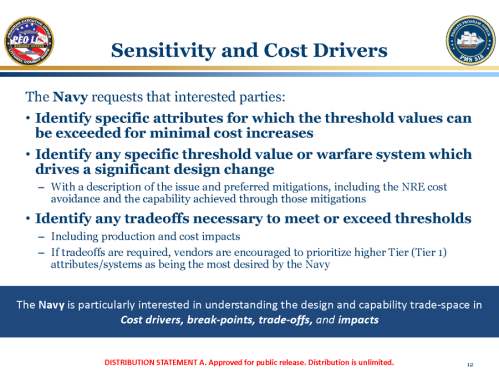Introduction
This report provides background information and discusses potential issues for Congress regarding the Navy's FFG(X) program, a program to procure a new class of 20 guided-missile frigates (FFGs). The Navy wants to procure the first FFG(X) in FY2020. The Navy's proposed FY2019 budget requests $134.8 million in research and development funding for the program.
The FFG(X) program presents several potential oversight issues for Congress. Congress's decisions on the program could affect Navy capabilities and funding requirements and the shipbuilding industrial base.
This report focuses on the FFG(X) program. A related Navy shipbuilding program, the Littoral Combat Ship (LCS) program, is covered in a separate CRS report.1 Other CRS reports discuss the strategic context within which the FFG(X) program and other Navy acquisition programs may be considered.2
Background
Navy's Force of Small Surface Combatants (SSCs)
SSC Definition
In discussing its force-level goals and 30-year shipbuilding plans, the Navy organizes its surface combatants into large surface combatants (LSCs), meaning the Navy's cruisers and destroyers, and small surface combatants (SSCs), meaning the Navy's frigates, Littoral Combat Ships, mine warfare ships, and patrol craft.3 SSCs are smaller, less capable in some respects, and individually less expensive to procure, operate, and support than LSCs.
SSC Force-Level Goal
In December 2016, the Navy released a goal to achieve and maintain a Navy of 355 ships, including 52 SSCs. Although patrol craft are SSCs, they do not count toward the 52-ship SSC force-level goal, because patrol craft are not considered battle force ships, which are the kind of ships that count toward the quoted size of the Navy and the Navy's force-level goal.4
SSC Force at End of FY2017
At the end of FY2017, the Navy's force of SSCs totaled 22 battle force ships, including the following:
0 frigates;
11 LCSs; and
11 mine warfare ships.
U.S. Navy Frigates in General
In contrast to cruisers and destroyers, which are designed to operate in higher-threat areas, frigates are generally intended to operate more in lower-threat areas. U.S. Navy frigates perform many of the same peacetime and wartime missions as U.S. Navy cruisers and destroyers, but since frigates are intended to do so in lower-threat areas, they are equipped with fewer weapons, less-capable radars and other systems, and less engineering redundancy and survivability than cruisers and destroyers.5
The most recent class of frigates operated by the Navy was the Oliver Hazard Perry (FFG-7) class (Figure 1). A total of 51 FFG-7 class ships were procured between FY1973 and FY1984. The ships entered service between 1977 and 1989, and were decommissioned between 1994 and 2015.
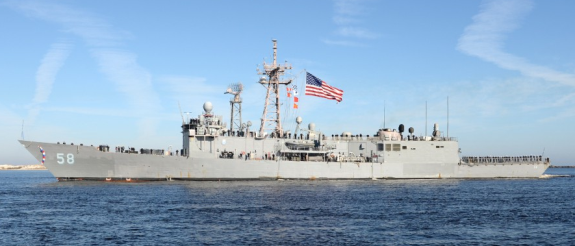 |
|
Source: Photograph accompanying Dave Werner, "Fighting Forward: Last Oliver Perry Class Frigate Deployment," Navy Live, January 5, 2015, accessed September 21, 2017, at http://navylive.dodlive.mil/2015/01/05/fighting-forward-last-oliver-perry-class-frigate-deployment/. |
In their final configuration, FFG-7s were about 455 feet long and had full load displacements of roughly 3,900 tons to 4,100 tons. (By comparison, the Navy's Arleigh Burke [DDG-51] class destroyers are about 510 feet long and have full load displacements of roughly 9,300 tons.) Following their decommissioning, a number of FFG-7 class ships, like certain other decommissioned U.S. Navy ships, have been transferred to the navies of U.S. allied and partner countries.
FFG(X) Program
Meaning of Designation FFG(X)
In the program designation FFG(X), FF means frigate,6 G means guided-missile ship (indicating a ship equipped with an area-defense AAW system),7 and (X) indicates that the design of the ship has not yet been determined. FFG(X) thus means a guided-missile frigate whose design has not yet been determined.8
Program Quantity
The Navy notionally wants to procure a notional total of 20 FFG(X)s, which in combination with 32 LCSs would meet the Navy's 52-ship SSC force-level goal. The Navy's proposed FY2018 budget requested the procurement of the 30th and 31st LCSs. As part of its action on the Navy's proposed FY2018 budget, Congress procured three LCSs—one more than the two that were requested. Thus, a total of 32 LCSs have been procured through FY2018.
The Navy's proposed FY2019 budget, which was submitted to Congress before Congress finalized action on the Navy's FY2018 budget, requests $646.2 million for the procurement of one LCS. If Congress had procured two LCSs in FY2018, as requested by the Navy, the LCS requested for procurement in FY2019 would have been the 32nd LCS. With the procurement of three LCSs in FY2018, the LCS requested for procurement in FY2019 would be the 33rd LCS. Given the 52-ship SSC force-level goal, if a 33rd LCS is procured in FY2019, this might imply a total procurement of 19 FFG(X)s rather than 20.
Procurement Schedule
Following a final year of LCS procurement in FY2019, the Navy wants to procure the first FFG(X) in FY2020, the second in FY2021, and the remaining 18 at a rate of two per year in FY2022-FY2030.
Ship Capabilities and Design
As mentioned above, the (X) in the program designation FFG(X) means that the design of the ship has not yet been determined. In general, the Navy envisages the FFG(X) as follows:
- The ship is to be a multimission small surface combatant capable of conducting AAW, ASuW, ASW, and EMW operations.
- Compared to an FF concept that emerged under a February 2014 restructuring of the LCS program, the FFG(X) is to have increased AAW and EMW capability, and enhanced survivability.
- The ship's area-defense AAW system is to be capable of local area AAW, meaning a form of area-defense AAW that extends to a lesser range than the area-defense AAW that can be provided by the Navy's cruisers and destroyers.
- The ship is to be capable of operating in both blue water (i.e., mid-ocean) and littoral (i.e., near-shore) areas.
- The ship is to be capable of operating either independently (when that is appropriate for its assigned mission) or as part of larger Navy formations.
Given the above, the FFG(X) design will likely be larger in terms of displacement, more heavily armed, and more expensive to procure than either the LCS or the FF concept that emerged from the February 2014 LCS program restructuring.
A November 2, 2017, Navy information paper on the combat system to be used by the FFG(X) states the following:
In considering multiple options (Lockheed Martin's COMBATSS-21, General Dynamics' Integrated Combat Management System, and Raytheon's Ship Self Defense System) for the Frigate's Combat Management System (CMS), the following criteria were analyzed:
—Commonality—the degree to which the CMS was common across variants of LCS and the rest of the Navy.
—Performance—demonstrated ability to deliver a certifiable CMS able to meet LCS requirements, with respect to mission area capabilities.
—Cost—the total cost to design, develop, deliver, test and sustain the CMS.
A derivation of the AEGIS combat system widely used throughout the Navy and half of the LCS platforms, the Navy selected COMBATSS-21 as the Frigate CMS. It offered the highest level of commonality, best performance, and lowest cost of the three options.
Similar to the original FF, the primary mission areas for the FFG(X) will be Anti-Submarine Warfare, Surface Warfare, and Electromagnetic Maneuver Warfare. In addition, the FFG(X) will provide upgraded Air Warfare capability and improved lethality and survivability that include a scaled SPY-6 Fixed Array Radar, Standard Missile, Evolved Sea Sparrow Missile, full Surface Electronic Warfare Improvement Program Block 2 capability, and a Cooperative Engagement Capability. The CMS capabilities required to bring these enhancements are already included in Aegis; and thus, they are much simpler to cost effectively incorporate into COMBATSS-21.9
Unit Procurement Cost
Follow-On Ships
The Navy wants the follow-on ships in the FFG(X) program (i.e., ships 2 through 20) to have an average unit procurement cost of $800 million to $950 million each in constant 2018 dollars.10 By way of comparison, the two LCSs that the Navy requested for FY2018 had an estimated average unit procurement cost of about $568 million each (not including the cost of their embarked mission packages), and the three DDG-51 class destroyers that the Navy has requested for FY2019 have an estimated average unit procurement cost of about $1,764 million each.
On July 10, 2017, the Navy released a Request for Information (RFI) to industry to solicit information for better understanding potential trade-offs between cost and capability in the FFG(X) design.11 On July 25, the Navy continued that effort by holding an industry day event. On July 28, the Navy posted its briefing slides for that event; some of those slides are reprinted in the Appendix.12 Responses to the RFI were due by August 24, 2017. The Navy states that it "received a very robust response to the FFG(X) RFI inclusive of [i.e., including] domestic and foreign ship designs and material vendor solutions."13 The Navy folded information gained through that RFI into its determination of the target unit procurement cost for the FFG(X).
Lead Ship
The Navy has not yet established a target unit procurement cost for the lead ship in the program. As shown in Table 1 below, however, the Navy's FY2019 budget submission programs $1,228.2 million (i.e., about $1.2 billion) in procurement funding for FY2020, the year that the first FFG(X) is to be procured. The lead ship in the program will be considerably more expensive than the follow-on ships in the program, because the lead ship's procurement cost will incorporate most or all of the detailed design/nonrecurring engineering (DD/NRE) costs for the class. (It is a traditional Navy budgeting practice to attach most or all of the DD/NRE costs for a new ship class to the procurement cost of the lead ship in the class.)
Acquisition Strategy
Parent-Design Approach
The Navy's desire to procure the first FFG(X) in FY2020 does not allow enough time to develop a completely new design (i.e., a clean-sheet design) for the FFG(X). (Using a clean-sheet design might defer the procurement of the first ship to about FY2023.) Consequently, the Navy intends to build the FFG(X) to a modified version of an existing ship design—an approach called the parent-design approach. The parent design could be a U.S. ship design or a foreign ship design.14
Using the parent-design approach can reduce design time, design cost, and technical, schedule, and cost risk in building the ship. The Coast Guard and the Navy are currently using the parent-design approach for the Coast Guard's polar icebreaker program.15 The parent-design approach has also been used in the past for other Navy and Coast Guard ships, including Navy mine warfare ships16 and the Coast Guard's new Fast Response Cutters (FRCs).17
No New Technologies or Systems
As an additional measure for reducing technical, schedule, and cost risk in the FFG(X) program, the Navy envisages developing no new technologies or systems for the FFG(X)—the ship is to use systems and technologies that already exist or are already being developed for use in other programs.
Builder
Given the currently envisaged procurement rate of two ships per year, the Navy envisages using a single builder to build the ships.18 Consistent with U.S. law,19 the ship is to be built in a U.S. shipyard, even if it is based on a foreign design. Using a foreign design might thus involve cooperation or a teaming arrangement between a U.S. builder and a foreign developer of the parent design.
Full and Open Competition
The Navy intends to conduct a full and open competition to select the builder of the FFG(X), including proposals based on either U.S. or foreign parent designs. On February 16, the Navy awarded five FFG(X) conceptual design contracts with a value of $15.0 million each to
- Austal USA of Mobile, AL;
- Huntington Ingalls Industry/Ingalls Shipbuilding (HII/Ingalls) of Pascagoula, MS;
- Lockheed Martin of Baltimore, MD;
- Fincantieri/Marinette Marine (F/MM) of Marinette, WI; and
- General Dynamics/Bath Iron Works (GD/BIW), of Bath, ME.20
A February 16, 2018, press report states
"These conceptual designs will reduce FFG(X) risk by enabling industry to mature designs to meet the approved FFG(X) capability requirements," read a late Friday [February 16] statement from Naval Sea Systems Command.
"The contracts based on these requirements will facilitate maturing multiple designs during the 16 months of the conceptual design phase, and will allow the Navy to better understand the cost and capability drivers across the various design options. Furthermore, this will inform the final specifications for a full and open competition with a single source award in FY20 for Detail Design and Construction (DD&C) of the FFG(X)."...
The Navy would not confirm how many groups bid for the work. At least one U.S.-German team that was not selected for a design contract, Atlas USA and ThyssenKrupp Marine Systems, told USNI News they had submitted for the competition....
During last month's Surface Navy Association [annual symposium], several shipbuilders outlined their designs for the FFG(X) competition.
Austal USA
Shipyard: Austal USA in Mobile, Ala.
Parent Design: Independence-class [i.e., LCS-2 class] Littoral Combat Ship
One of the two Littoral Combat Ship builders, Austal USA has pitched an upgunned variant of the Independence-class LCS as both a foreign military sales offering and as the answer to the Navy's upgunned small surface combatant and then frigate programs. Based on the 3,000-ton aluminum trimaran design, the hull boasts a large flight deck and space for up to 16 Mk-41 Vertical Launching System (VLS) cells.
Fincantieri Marine Group
Shipyard: Fincantieri Marinette Marine in Marinette, Wisc.
Parent Design: Fincantieri Italian FREMM
As part of the stipulations of the FFG(X) programs, a contractor can offer just one design in the competition as a prime contractor but may also support a second bid as a subcontractor. Fincantieri elected to offer its 6,700-ton Italian Fregata europea multi-missione (FREMM) design for construction in its Wisconsin Marinette Marine shipyard, as well as partner with Lockheed Martin on its Freedom-class pitch as a subcontractor. The Italian FREMM design features a 16-cell VLS as well as space for deck-launched anti-ship missiles.
General Dynamics Bath Iron Works
Shipyard: Bath Iron Works in Bath, Maine
Parent Design: Navantia Álvaro de Bazán-class F100 Frigate
The 6,000-ton air defense guided-missile frigates fitted with the Aegis Combat System have been in service for the Spanish Armada since 2002 and are the basis of the Australian Hobart-class air defense destroyers and the Norwegian Fridtjof Nansen-class frigates. The Navantia partnership with Bath is built on a previous partnership from the turn of the century. The F100 frigates were a product of a teaming agreement between BIW, Lockheed Martin and Navantia predecessor Izar as part of the Advanced Frigate Consortium from 2000.
Huntington Ingalls Industries
Shipyard: Ingalls Shipbuilding in Pascagoula, Miss.
Parent Design: Unknown
Out of the competitors involved in the competition, HII was the only company that did not present a model or a rendering of its FFG(X) at the Surface Navy Association symposium in January. A spokeswoman for the company declined to elaborate on the offering when contacted by USNI News on Friday. In the past, HII has presented a naval version of its Legend-class National Security Cutter design as a model at trade shows labeled as a "Patrol Frigate."
Lockheed Martin
Shipyard: Fincantieri Marinette Marine in Marinette, Wisc.
Parent Design: Freedom-class [i.e., LCS-1 class] Littoral Combat Ship
Of the two LCS builders, Lockheed Martin is the first to have secured a foreign military sale with its design. The company's FFG(X) bid will have much in common with its offering for the Royal Saudi Navy's 4,000-ton multi-mission surface combatant. The new Saudi ships will be built around an eight-cell Mk-41 vertical launch system and a 4D air search radar. Lockheed has pitched several other variants of the hull that include more VLS cells.
"We are proud of our 15-year partnership with the U.S. Navy on the Freedom-variant Littoral Combat Ship and look forward to extending it to FFG(X)," said Joe DePietro, Lockheed Martin vice president of small combatants and ship systems in a Friday evening statement.
"Our frigate design offers an affordable, low-risk answer to meeting the Navy's goals of a larger and more capable fleet."21
The Navy wants to release a request for proposals (RFP) in the fourth quarter of FY2019, and award a detailed design and construction (DD&C) contract for the program in FY2020.22 Being a recipient of a conceptual design contract is not a requirement for competing for the DD&C contract.
Block Buy Contracting
As a means of reducing their procurement cost, the Navy envisages using one or more fixed-price block buy contracts to procure the ships.23
Program Funding
Table 1 shows funding for the FFG(X) program under the Navy's FY2019 budget submission.
|
Prior years |
FY17 |
FY18 |
FY19 |
FY20 |
FY21 |
FY22 |
FY23 |
|
|
Research and development |
18.9 |
83.1 |
141.1 |
134.8 |
75.4 |
77.6 |
70.5 |
72.0 |
|
Procurement |
0 |
0 |
0 |
0 |
1,228.2 |
849.1 |
1,791.9 |
1,792.0 |
|
(Procurement quantity) |
(1) |
(1) |
(2) |
(2) |
Source: Navy FY2019 budget submission and (for FY2018) explanatory statement for FY2018 DOD appropriations act (Division C of H.R. 1625/P.L. 115-141 of March 23, 2018).
Notes: Research and development funding is located in PE (Program Element) 0603599N, Frigate Development (Navy research and development account line 57 in the FY2019 budget submission), and additionally (for prior years only), PE 0603581, Littoral Combat Ship.
Issues for Congress
FY2019 Funding Request
One potential oversight issue for Congress is whether to approve, reject, or modify the Navy's FY2019 funding request for the program. In assessing this question, Congress may consider, among other things, whether the work the Navy is proposing to do in the program in FY2019 is appropriate, and whether the Navy has accurately priced that work.
Analytical Basis for Capability Gaps/Mission Needs
Another potential oversight issue for Congress is whether the Navy has accurately identified the capability gaps and mission needs to be addressed by the program, particularly in light of recent changes in the international security environment and debate over the future U.S. role in the world,24 and whether the Navy has performed a formal, rigorous analysis of this issue, as opposed to relying solely on the subjective judgments of Navy and DOD leaders.
Subjective judgments can be helpful, particularly in terms of capturing knowledge and experience that is not easily reduced to numbers, in taking advantage of the "wisdom of the crowd," and in coming to conclusions and making decisions quickly. On the other hand, a process that relies heavily on subjective judgments can be vulnerable to groupthink (i.e., a situation in which a group acts in a way that discourages creativity or individual responsibility), can overlook counterintuitive results regarding capability gaps and mission needs (i.e., results that go against the conventional wisdom), and, depending on the leaders involved, can emphasize those leaders' understanding of the Navy's needs in the nearer term, as opposed to what a formal intelligence projection of future adversary capabilities—such as those used in formal, rigorous analyses—might indicate what the Navy will need years from now, when the new ships will actually be in the fleet.
A May 18, 2018, Navy information paper states:
The analytics behind the requirement for a Small Surface Combatant (SSC) with the above capabilities and characteristics started with work completed during the SSC Task Force (SSCTF)between February and November 2014, which recommended improvements to LCS in order to provide a more lethal and survivable SSC. The SSCTF culminated in a CNO and Joint Requirements Oversight Council (JROC) validated LCS Flight 0+ Frigate Increment Capabilities Development Document (CDD) in April 2016....
Subsequent to the SSCTF effort, the FY16 NDAA directed three independent 2030 Future Fleet Architecture (FFA) analysis studies. The three NDAA mandated studies were conducted by CSBA (Center for Strategic and Budgetary Assessments), the MITRE Corporation, and the Navy Project Team. Each presented different visions of a 2030 FFA across platforms and missions, but all coalesced around the need for a multi-mission SSC with specific capabilities/characteristics, forward stationed and rotationally crewed to support forward presence, deterrence, and lethal distributed operations within budgetary constraints....
The requirements for a future Small Surface Combatant (SSC) or Guided Missile Frigate (FFG) proposed in the three NDAA mandated FFA studies were validated through a series of table top exercises (TTX) and campaign analyses conducted by OPNAV N81 in support of N9....
In January 2017, the Navy convened the FFG Requirements Evaluation Team to analyze the capabilities needed above those prescribed by the FF CDD [Capability Development Document] to include Air Warfare (Local Air Defense), survivability (reduced susceptibility and vulnerability), and EMW to support DMO in a contested environment. This update to the FF CDD reflected a maturing of the three FFG concepts presented in the NDAA studies coupled with a thorough analysis of capability gaps and mission needs that are reflected in the draft FFG(X) CDD requirements. To date, these requirements have been continually refined and recent Future Surface Combatant and FFA wargames have also confirmed and refined the necessity for a SSC with the capability required by the FFG(X) CDD.25
A December 4, 2017, press report states
Rear Adm. Ron Boxall [the Navy's director of surface warfare] told USNI News today at the American Society of Naval Engineers' annual Combat Systems Symposium that the 60-day effort by the FFG Requirements Evaluation Team helped each stakeholder understand how their needs interacted with others' to affect cost, schedule, operational effectiveness and more..
"I was very pleased with where we came out because some of the decisions were much more about the concept of what we're getting instead of the actual platform we're getting," Boxall told USNI News during a question and answer period after his remarks....
... Boxall said the process the 60-day requirements evaluation teams have used is also very exciting for the requirements community. In some past cases, such as the CG(X) next-generation cruiser, requirements officers have spent years on a program, only to have it ultimately canceled.26 With this new process that brings together all stakeholders right at the start, along with computer tools that allow them to generate numerous iterations of a ship design, the Navy can work through a program's requirements much faster and come up with a more mature and technologically informed set of requirements.
"What's exciting about this [is] we're starting to create a repository of knowledge that we can use to reiterate as we need to go along," he told USNI News after the event.
"We've not done a good job of doing that in the past, it's was kind of resident in the requirements officers and the acquisition team; now we're actually doing it with the models—here's what this combination of capabilities proves to get to us, and as we learn things or technology improves or costs more or less, we can make adjustments a lot more quickly."
Asked about applying this methodology to more programs, like the Future Surface Combatant family of systems that followed the canceled CG(X), Boxall said those discussions have already begun.
"We actually took some of the work we're doing with Future Surface Combatant and brought that back (to the FFG Requirements Evaluation Team); we said hey, the Future Surface Combatant is about where we're going with the whole family of ships, so if we're going to be producing an FFG of the future that's going to be kind of at the small surface combatant size, then we don't want that to be disconnected," he said. And moving forward with the large, small and unmanned surface combatants the Navy is considering for the Future Surface Combatant family, Boxall said the designs that have already been iterated can be used as a good starting point for future efforts.27
A December 5, 2017, press report, reporting on the same symposium, stated
The Navy is convening a team similar to one used to help create the guided-missile future frigate FFG(X) to also alter the direction of the Zumwalt-class [DDG-1000] destroyers, Rear Adm. Ronald Boxall, director of Surface Warfare, said here at the 2017 Combat Systems Symposium organized by the American Society of Naval Engineers (ASNE)....
When working out new frigate requirements, the Navy looked to see what capabilities they could take from its predecessor, the Littoral Combat Ship (LCS) to help make it ready to be on contract by fiscal year (FY) 2020. He said that process involved meetings involving officials in the Navy's requirements, acquisition, and fleet teams.
Personnel "learned why they were stupid" from the perspective of the other components, he said. Each component thought the other made serious mistakes, but also learned what those teams thought of them.
Boxall said the fleet personnel would say what the warfighters need to accomplish a certain mission, the acquisition teams would draw up what they asked for and more, "then the price goes through the roof."
He said to resolve the high price versus requirements problems there has to be a voice of "hey, I want that but it's really expensive. And you say, well, here's where we can get 'tastes great and less filling'" to balance priorities and price.
Boxall said he was very pleased with the decisions the Navy made going into the FFG(X) requirements and now they decided to try it again with the Zumwalt-class.28
Analytical Basis for Addressing Capability Gaps/Mission Needs with an FFG
Another potential oversight issue for Congress is whether procuring a new class of FFGs is the best or most promising general approach for addressing the identified capability gaps and mission needs, and whether the Navy has performed a formal, rigorous analysis of this issue, as opposed to relying solely on subjective judgments of Navy or DOD leaders. Similar to the points made in the previous section, subjective judgments, though helpful, can overlook counterintuitive results regarding the best or most promising general approach. Potential alternative general approaches for addressing identified capability gaps and mission needs in this instance include (to cite a few possibilities) modified LCSs, FFs, destroyers, aircraft, unmanned vehicles, or some combination of these platforms.
A formal, rigorous analysis to determine the best or most promising general approach for addressing a set of capability gaps or mission needs was in the past sometimes referred to as an analysis of multiple concepts (AMC), or more generally as competing the mission. It could also be called an analysis of alternatives (AOA), though that term can also be applied to an analysis for refining the desired capabilities of the best or most promising approach that has been identified by an AMC.
As discussed in CRS reports on the LCS program over the years, the Navy did not perform a formal, rigorous analysis of this kind prior to announcing the start of the LCS program in November 2001, and this can be viewed as a root cause of much of the debate and controversy the that attended the LCS program, and of the program's ultimate restructurings in February 2014 and December 2015.29
See also the passages from the May 18, 2018, Navy information paper and the December 4 and 5, 2017, press reports that are quoted in the previous section.
Growth Margin
Another potential oversight issue for Congress whether the Navy has chosen the appropriate amount of growth margin to incorporate into the FFG(X) design. As shown in the Appendix, the Navy wants the FFG(X) design to have a growth margin (also called service life allowance) of 5%, meaning an ability to accommodate upgrades and other changes that might be made to the ship's design over the course of its service life that could require up to 5% more space, weight, electrical power, or equipment cooling capacity. As shown in the Appendix, the Navy also wants the FFG(X) design to have an additional growth margin for accommodating a future directed energy system (i.e., a laser or high-power microwave device) or an active electronic attack system (i.e., electronic warfare system).
Supporters could argue that a 5% growth margin is traditional for a ship like a frigate, that the FFG(X)'s 5% growth margin is supplemented by the additional growth margin for a directed energy system or active electronic attack system, and that requiring a larger growth margin could make the FFG(X) design larger and more expensive to procure.
Skeptics might argue that a larger growth margin (such as 10%—a figure used in designing cruisers and destroyers) would provide more of a hedge against the possibility of greater-than-anticipated improvements in the capabilities of potential adversaries such as China,30 that a limited growth margin was a concern in the FFG-7 design,31 and that increasing the FFG(X) growth margin from 5% to 10% would have only a limited impact on the FFG(X)'s procurement cost.
Parent-Design Approach
Another potential oversight issue for Congress concerns the Navy's proposed acquisition strategy for the program, including the Navy's intent to use a parent-design approach for the program. One alternative would be to use a clean-sheet design approach, under which procurement of the FFG(X) would begin about FY2023 and procurement of LCSs might be extended through about 2022.
As mentioned earlier, using the parent-design approach can reduce design time, design cost, and technical, schedule, and cost risk in building the ship. A clean-sheet design approach, on the other hand, might result in a design that more closely matches the Navy's desired capabilities for the FFG(X), which might make the design more cost-effective for the Navy over the long run. It might also provide more work for the U.S. ship design and engineering industrial base.
Another possible alternative would be to consider frigate designs that have been developed, but for which there are not yet any completed ships. This approach might make possible consideration of designs, such as (to cite just one possible example) the UK's new Type 26 frigate design, production of which was in its early stages in 2018. Compared to a clean-sheet design approach, using a developed-but-not-yet-built design would offer a reduction in design time and cost, but might not offer as much reduction in technical, schedule, and cost risk in building the ship as would be offered by use of an already-built design.
Navy's Plan for Shifting Procurement from LCS to FFG(X)
Another potential oversight issue for Congress is whether to approve, reject, or modify the Navy's plan to procure a final LCS in FY2019 and shift to procurement of FFG(X)s starting in FY2020. As noted earlier, the Navy's plan to end LCS procurement in FY2019 and shift to FFG(X) procurement starting in FY2020 would achieve the Navy's 52-ship SSC force-level goal by about 2035. The Navy's plan would also have implications for workloads and employment levels at the two LCS shipyards and their supplier firms
- If a modified LCS is chosen as the winner of the FFG(X) competition, then other things held equal (e.g., without the addition of new work other than building LCSs), workloads and employment levels at the other LCS shipyard (the one whose modified LCS design is not chosen for the FFG(X) program), as well as supplier firms associated with that other LCS shipyard, would decline over time as the other LCS shipyard's backlog of prior-year-funded LCSs is completed and not replaced with new FFG(X) work.
- If a modified LCS is not chosen as the FFG(X)—that is, if the winner of the FFG(X) competition is a proposal based on a hull design other than the two existing LCS designs—then other things held equal, employment levels at both LCS shipyards and their supplier firms would decline over time as their backlogs of prior-year-funded LCSs are completed and not replaced with FFG(X) work.
There are many possible alternatives to the Navy's plan to end LCS procurement in FY2019 and shift to FFG(X) procurement starting in FY2020. One of these, for example, would be to select a winner in the FFG(X) competition and begin procuring that design in FY2020, as the Navy currently plans, but also produce FFG(X)s at one or both of the LCS yards. Under this option, if the winner of the FFG(X) competition is one of the LCS builders, that builder might build more than half of the FFG(X)s to its winning design, and the other LCS yard would build less than half of the FFG(X)s to its own nonwinning (but presumably still-capable) FFG(X) design. Alternatively, if the winner of the FFG(X) competition is neither of the LCS builders, the winning bidder build might build the largest share of the FFG(X)s to its winning design, and the two LCSs yards would each build a smaller number of FFG(X)s to their own nonwinning (but presumably still-capable) designs.
Supporters of this option might argue that it could
- boost FFG(X) production from the currently planned two ships per year to as many as many as four to six ships per year, substantially accelerating the date for attaining the Navy's 52-ship SSC force-level goal;
- permit the Navy to use competition (either competition for quantity at the margin, or competition for profit [i.e., Profit Related to Offers, or PRO, bidding])32 to help restrain FFG(X) prices and ensure production quality and on-time deliveries; and
- complicate adversary defense planning by presenting potential adversaries with multiple FFG(X) designs, each with its own specific operating characteristics.
Opponents of this plan might argue that it could
- weaken the FFG(X) competition by offering the winner a smaller prospective number of FFG(X)s and essentially guaranteeing the LCSs yard that they will build some number of FFG(X)s;
- substantially increase annual FFG(X) procurement funding requirements so as to procure as many as four to six FFG(X)s per year rather than two per year, which in a situation of finite DOD funding could require offsetting reductions in other Navy or DOD programs; and
- reduce production economies of scale in the FFG(X) program by dividing FFG(X) among two or three designs, and increase downstream Navy FFG(X) operation and support (O&S) costs by requiring the Navy to maintain two or three FFG(X) logistics support systems.
Another possible alternative to the Navy's plan to end LCS procurement in FY2019 and shift to FFG(X) procurement starting in FY2020 would be would be to select a winner in the FFG(X) competition and begin procuring that design in FY2020, as the Navy currently plans, but shift Navy shipbuilding work at one of the LCS yards (if the other wins the FFG(X) competition) or at both of the LCS yards (if neither wins the FFG(X) competition) to the production of sections of larger Navy ships (such as DDG-51 destroyers or amphibious ships) that undergo final assembly at other shipyards. Under this option, in other words, one or both of the LCS yards would be converted into feeder yards supporting the production of larger Navy ships that undergo final assembly at other shipyards. This option might help maintain workloads and employment levels at one or both of the LCS yards, and might alleviate capacity constraints at other shipyards, permitting certain parts of the Navy's 355-ship force-level objective to be achieved sooner.
The concept of feeder yards in naval shipbuilding was examined at length in a 2011 RAND report.33 The Navy in recent years has made some use of the concept
- All Virginia-class attack submarines have been produced jointly by General Dynamics' Electric Boat division (GD/EB) and Huntington Ingalls Industries' Newport News Shipbuilding (HII/NNS), with each yard in effect acting as a feeder yard for Virginia-class boats that undergo final assembly at the other yard.34
- Certain components of the Navy's three Zumwalt (DDG-1000) class destroyers were produced by HII's Ingalls Shipyard (HII/Ingalls) and then transported to GD's Bath Iron Works (GD/BIW), the primary builder and final assembly yard for the ships.
- San Antonio (LPD-17) class amphibious ships were built at the Ingalls shipyard at Pascagoula, MS, and the Avondale shipyard near New Orleans, LA. These shipyards were owned by Northrop and later by HII. To alleviate capacity constraints at Ingalls and Avondale caused by damage from Hurricane Katrina in 2005, Northrop subcontracted the construction of portions of LPDs 20 through 24 (i.e., the fourth through eighth ships in the class) to other shipyards on the Gulf Coast and East Coast, including shipyards not owned by Northrop.35
The above options are only two of many possible alternatives to the Navy's plan to end LCS procurement in FY2019 and shift to FFG(X) procurement starting in FY2020.
Technical Risk
Another potential oversight issue concerns technical risk in the FFG(X) program. An April 2018 report from the Government Accountability Office on the status of various DOD acquisition programs states the following about the FFG(X) program:
Current Status
In May 2017, the Navy shifted away from its plan for a new frigate derived from minor modifications to an LCS design and now plans to select a new frigate design and shipbuilder through a full and open competition that is not limited to LCS derivatives. The program intends to leverage the proposed capabilities of the original frigate program and expand upon them to create a more lethal and survivable ship.
In fiscal year 2018, the FFG(X) program plans to focus on system specifications development and approval, acquisition program documentation needs, test strategy development, and combat management system integration. The program released a request for conceptual design proposals in November 2017 and plans to award multiple contracts in 2018 in an effort to reduce risk by maturing industry designs to meet FFG(X) capability needs.
Consistent with statute and knowledge-based practices, the Navy has scheduled a preliminary design review prior to a development start decision in February 2020. To support the development start decision, the program expects to complete an independent cost estimate, affordability and should-cost analyses, and an independent technical risk assessment. Although the number of planned frigates remains uncertain due to previous Secretary of Defense direction to cap the combined total of LCS and frigates at 40 ships, the program plans to award what the Navy refers to as a "block buy" contract for FFG(X) detail design and construction in September 2020. This block buy contract, which the Navy plans to award to a single shipbuilder, is intended to achieve more favorable pricing, but as planned, would require the Navy to commit to more than 1 year's worth of procurement in a single contract. If the Navy requests congressional authorization during 2019 for the planned fiscal year 2020 block buy, the Navy will lack key knowledge, such as an independent cost estimate, to support its request.
Program Office Comments
We provided a draft of this assessment to the program office for review and comment. The program stated that conceptual design allows the Navy to mature multiple designs and better understand cost and capability drivers across design options before a detail design and construction award, as well as inform final specifications that will achieve a best value solution.36
Potential Impact on Requirements for Cruisers and Destroyers
Another potential oversight issue for Congress is whether the FFG(X) program has any implications for required numbers or capabilities of U.S. Navy cruisers and destroyers. The Navy's goal to achieve and maintain a force of 104 cruisers and destroyers and 52 small surface combatants was determined in 2016, and may reflect an earlier plan to procure FFs, rather than the current plan to procure more-capable FFG(X)s. If so, a question might arise as to whether the current plan to procure FFG(X)s would permit a reduction in the required number of cruisers and destroyers, or in the required capabilities of those cruisers and destroyers. A September 7, 2018, press report stated:
Ahead of the Navy's next force-structure assessment [FSA], the service aims to "pull together something" quicker to help inform the fiscal year 2020 budget request, according to the Navy's top requirements officer….
[Vice Adm. William Merz, deputy chief of naval operations for warfare systems,] said Sept. 5 he'll be paying attention to the mix of large and small surface combatants.
"A lot of that will depend on our perception of what is this next frigate really going to look like," he said, referring to the future frigate, FFG(X). "How much capability and modernization are we actually going to be able to do to that ship? That could influence how much of another kind of ship we need."37
Legislative Activity for FY2019
Summary of Congressional Action on FY2019 Funding Request
Table 2 summarizes congressional action on the Navy's FY2019 funding request for the LCS program.
Table 2. Congressional Action on FY2019 FFG(X) Program Funding Request
Millions of dollars, rounded to nearest tenth.
|
Authorization |
Appropriation |
||||||
|
Request |
HASC |
SASC |
Conf. |
HAC |
SAC |
Conf. |
|
|
Research and development |
134.8 |
134.8 |
134.8 |
134.8 |
132.8 |
134.8 |
132.8 |
|
Procurement |
0 |
0 |
0 |
0 |
0 |
0 |
0 |
Source: Table prepared by CRS based on FY2019 Navy budget submission, committee and conference reports, and explanatory statements on the FY2019 National Defense Authorization Act and the FY2019 DOD Appropriations Act.
Notes: HASC is House Armed Services Committee; SASC is Senate Armed Services Committee; HAC is House Appropriations Committee; SAC is Senate Appropriations Committee; Conf. is conference agreement. Research and development funding is located in PE (Program Element) 0603599N, Frigate Development, which is line 57 in the Navy's FY2019 research and development account.
National Defense Authorization Act for Fiscal Year 2019/John S. McCain National Defense Authorization Act for Fiscal Year 2019 (H.R. 5515/S. 2987/P.L. 115-232)
House
The House Armed Services Committee, in its report (H.Rept. 115-676 of May 15, 2018) on H.R. 5515, recommended the funding levels for the FFG(X) program shown in the HASC column of Table 2.
Section 129 of H.R. 5515 as reported by the committee states:
SEC. 129. Frigate class ship program.
(a) Technical data.—
(1) REQUIREMENT.—As part of the solicitation for proposals for the procurement of any frigate class ship, the Secretary of the Navy shall require that an offeror submit a proposal that provides for conveying technical data as part of the proposal for the frigate.
(2) RIGHTS OF THE UNITED STATES.—The Secretary of the Navy shall ensure that the Government's rights in technical data for any frigate class ship are sufficient to allow the Government to—
(A) by not later than the date on which funds are obligated for the last covered frigate, use the technical data to conduct a full and open competition (pursuant to section 2304 of title 10, United States Code) for any subsequent procurement of a frigate class ship; and
(B) transition the frigate class ship combat systems to Government-furnished equipment to achieve open architecture and foster competition to modernize future systems.
(b) Definitions.—In this section:
(1) The term "covered frigate" means each of the first 10 frigate class ships procured after January 1, 2020.
(2) The term "technical data" means a compilation of detailed engineering plans and specifications for the construction of a frigate class ship.38
H.Rept. 115-676 states:
Frigate
The committee is aware that the Navy awarded five contracts for conceptual design for its new guided missile frigate program, FFG(X), with multiple shipbuilders currently developing their respective designs to compete for a detail design and construction contract award planned for September 2020. This pursuit represents a significant shift from the Navy's previous plans to award a contract in fiscal year 2018 for a frigate derived from minor modifications to a Littoral Combat Ship (LCS) design. The FFG(X) program intends to leverage the proposed capabilities of the previous frigate plans and expand upon them to create a more lethal and survivable ship to meet the Small Surface Combatant (SSC) requirement.
Toward that end, the committee encourages the Secretary of the Navy to emphasize concepts of risk reduction, commonality with existing platform equipment, and reduced acquisition and life cycle and sustainment costs to provide a best value solution for this critical platform. FFG(X) represents a significant investment, with the Navy's fiscal year 2019 long-range shipbuilding plan estimating over $5.5 billion through fiscal year 2023 for the first 6 frigates, and a total of 20 frigates planned through fiscal year 2030.
Since 2005, the Comptroller General of the United States has reported extensively on the LCS program, the predecessor small surface combatant. Considering the lessons learned during the LCS program, the committee directs the Comptroller General of the United States conduct a review of the FFG(X) program and provide a report to the congressional defense committees by March 1, 2019. The report shall include, at a minimum, analysis on the following:
(1) conceptual design plans and activities to support the advancement of multiple ship designs for a full and open competition in fiscal year 2020;
(2) activities to establish requirements and system specifications, and to develop the program's overall acquisition approach, including cost and schedule estimates, as well as a test strategy; and
(3) plans for the detail design and construction award contract, to include a review of the implications of a potential request by the Navy for a block buy award. (Page 17)
Senate
The Senate Armed Services Committee, in its report (S.Rept. 115-262 of June 5, 2018) on S. 2987, recommended the funding levels for the FFG(X) program shown in the SASC column of Table 2.
S.Rept. 115-262 states:
Guided missile frigate (FFG(X))
The committee applauds the Navy's decision to procure a guided missile frigate (FFG(X)) with increased lethality, survivability, and endurance to meet the requirement for Small Surface Combatants within the most recent Navy Force Structure Assessment. While maintaining the Navy's "high/low" mix of ships, the FFG(X) program greatly expands upon the capabilities of the Littoral Combat Ship program, returning many of the multi-mission warfighting attributes of Oliver Hazard Perry-class frigates to the fleet and enabling operations in more contested environments.
As the Navy refines FFG(X) concept designs with industry through fiscal year 2019, the committee continues to support a full and open competition with a single source detail design and construction award in fiscal year 2020. The committee also supports the Navy's approach to commonality with existing Navy platforms, such as the Mark-41 Vertical Launch System and Enterprise Air Surveillance Radar, to reduce acquisition and sustainment costs. The committee encourages the Navy not to trade-off warfighting capability for other considerations. (Page 44)
Conference
The conference report (H.Rept. 115-874 of July 25, 2018) on H.R. 5515/P.L. 115-232 of August 13, 2018 recommended the funding levels for the FFG(X) program shown in the authorization conference column of Table 2.
Section 128 of H.R. 5515 states:
SEC. 128. FRIGATE CLASS SHIP PROGRAM.
(a) IN GENERAL.—As part of the solicitation for proposals for the procurement of any frigate class ship in any of fiscal years 2019, 2020, or 2021, the Secretary of the Navy shall require that offerors submit proposals under which the offeror agrees to convey technical data to the Federal Government in the event the offeror is awarded the frigate construction contract associated with the proposal.
(b) TECHNICAL DATA DEFINED.—In this section, the term ''technical data'' means a compilation of detailed engineering plans and specifications for the construction of a frigate class ship.
Regarding Section 128, H.Rept. 115-874 states:
Frigate class ship program (sec. 128)
The House bill contained a provision (sec. 129) that would require, as part of the solicitation for proposals for the procurement of any frigate class ship, that the Secretary of the Navy require offerors to submit proposals that provide for conveying technical data to the government. Additionally, this provision would require the Secretary of the Navy to ensure that the government's technical data rights are sufficient to allow for specified follow-on activities.
The Senate amendment contained no similar provision.
The Senate recedes with an amendment that would remove the requirement for the Secretary of the Navy to ensure that the government's technical data rights are sufficient to allow for specified follow-on activities and clarify the conditions under which technical data shall be provided to the government.
The conferees' intent is to obtain sufficient technical data to ensure the Navy has the option to compete the winning frigate design in the future for production by at least one additional shipbuilder, if the Navy's inventory objective for FFG(X)-class ships merits such expansion. The conferees note that the benefits of two shipbuilders building the same ship design have been demonstrated in both the DDG–51 and CG–47 classes. The conferees do not intend for the winning frigate offeror to provide technical data beyond what is needed for a single-design, multiple-shipbuilder frigate acquisition strategy or otherwise authorized by law. (Page 802)
FY2019 DOD Appropriations Act (H.R. 6157/S. 3159 /Division A of H.R. 6157/P.L. 115-245)
House
The House Appropriations Committee, in its report (H.Rept. 115-769 of June 20, 2018) on H.R. 6157, recommended the funding levels for the FFG(X) program shown in the HAC column of Table 2. The recommended reduction of $2.0 million is for "Testing delays." (Page 248)
Senate
The Senate Appropriations Committee, in its report (S.Rept. 115-290 of June 28, 2018) on S. 3159, recommended the funding levels for the FFG(X) program shown in the SAC column of Table 2.
Conference
In final action, the FY2019 DOD Appropriations Act became Division A of the Department of Defense and Labor, Health and Human Services, and Education Appropriations Act, 2019, and Continuing Appropriations Act, 2019 (H.R. 6157/P.L. 115-245 of September 28, 2018).
The joint explanatory statement for H.R. 6157/P.L. 115-245 specified the funding levels shown in the appropriations conference column of Table 2. The reduction of $2.0 million is for "Testing and engineering delays." (PDF page 276 of 559)
Appendix. Navy Briefing Slides from July 25, 2017, FFG(X) Industry Day Event
This appendix reprints some of the briefing slides that the Navy presented at its July 25, 2017, industry day event on the FFG(X) program, which was held in association with the RFI that the Navy issued on July 25 to solicit information for better understanding potential trade-offs between cost and capability in the FFG(X) design (see "Unit Procurement Cost"). The reprinted slides begin on the next page.
|
Slides from Navy FFG(X) Industry Day Briefing
Source: Slides from briefing posted on July 28, 2017, at RFI: FFG(X) - US Navy Guided Missile Frigate Replacement Program, https://www.fbo.gov/index?s=opportunity&mode=form&tab=core&id=d089cf61f254538605cdec5438955b8e&_cview=0, accessed August 11, 2017. |
